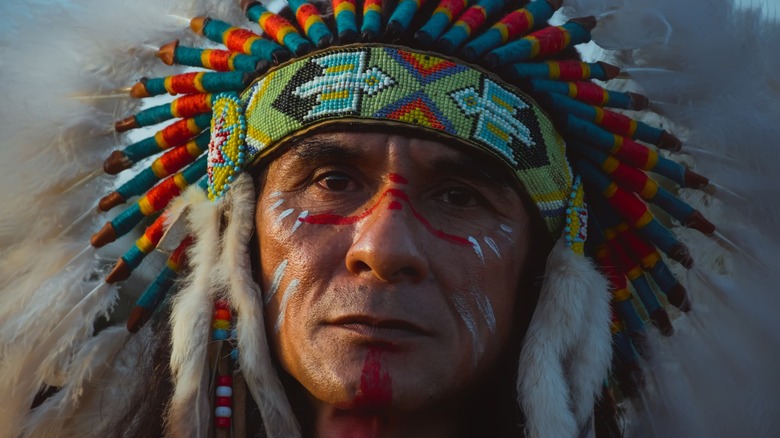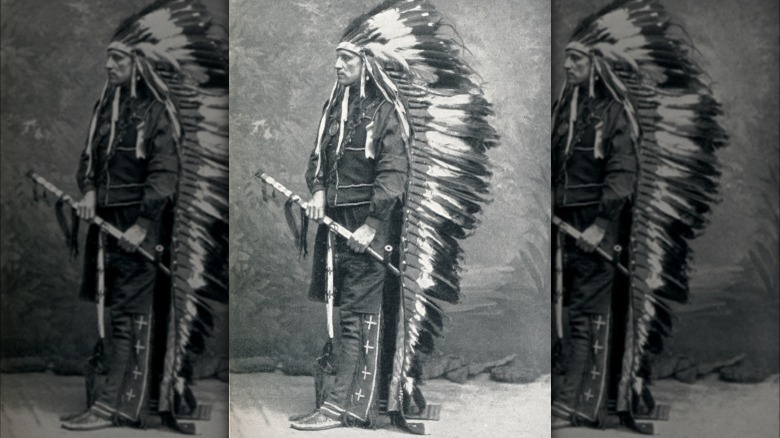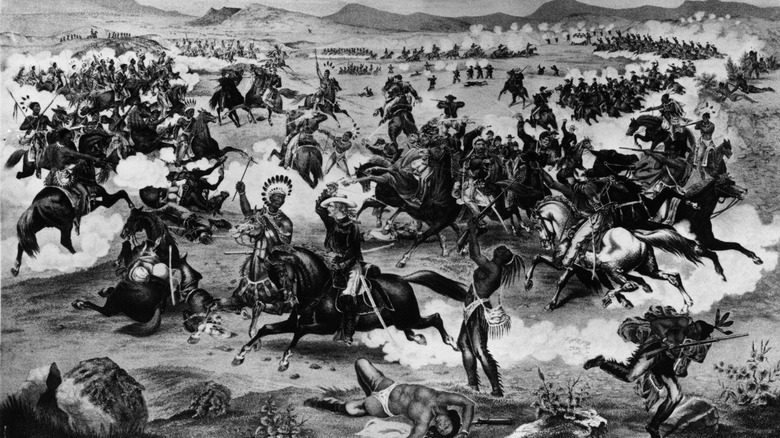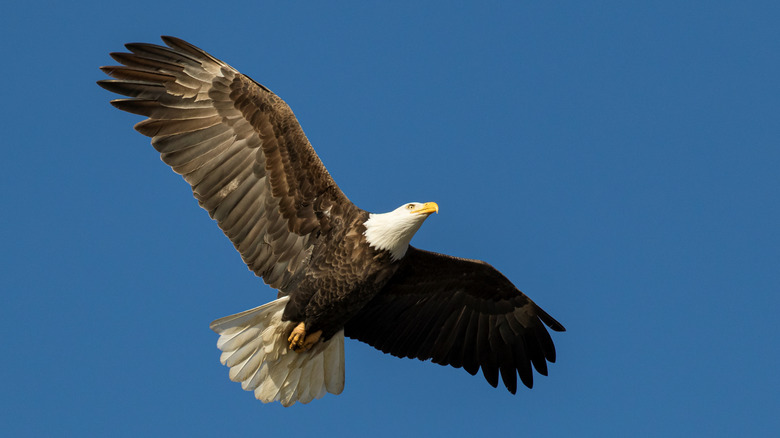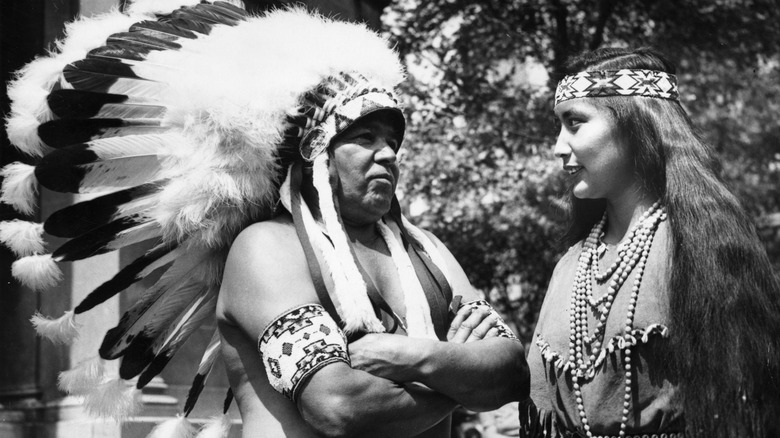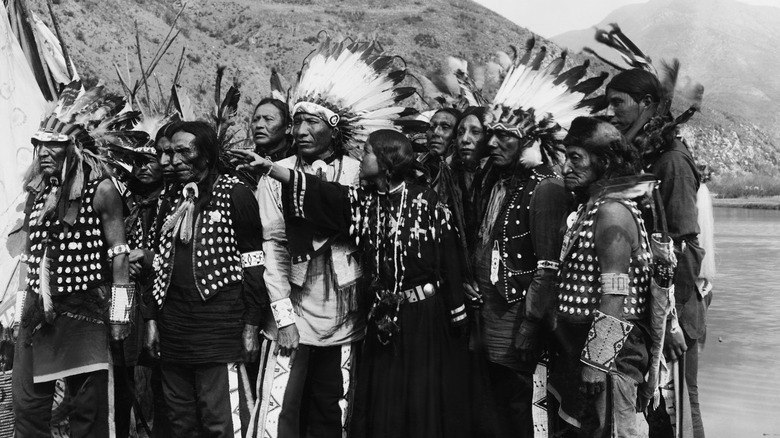The Untold Truth Of Native American War Bonnets
Feathered headdresses or war bonnets are of great importance in Native American culture. It's not merely an accessory that anyone can wear; rather, it's a symbol of bravery and great deeds. Unbeknownst to many, not just any Native American gets the privilege to wear a war bonnet. It's reserved for those who have gone into battle or serve high ranks within a tribe. According to Kachina House, each feather on a war bonnet represents a selfless act that was accomplished during battle or was done for the tribe. Typically, chiefs and warriors in the tribe are the ones who are entitled to wear war bonnets.
Since each part of a war bonnet is representative of a brave act, they come in different lengths and shapes. Some are fashioned to go down the length of the back, while others are made in a circular shape that looks more like a crown. Warriors may sometimes wear a war bonnet during battle, but longer and bigger war bonnets are usually only worn during important tribal ceremonies (via Old Dominion University).
Types of war bonnets
There are different types of war bonnets that Native Americans use. Perhaps the most common war bonnet depicted in the media is the one full-feathered war bonnet. However, contrary to what many believe, not all Native American tribes wear the same type of war bonnet.
One type is the trailer war bonnet, which consists of rows of feathers that extend down the wearer's back, sometimes even reaching the feet, per Indian Traders. Halo war bonnets, on the other hand, are the ones with feathers arranged around the face and head, much like a crown. Another type is the straight-up war bonnet, where long and narrow feathers are attached to the headdress in an upright position. Aside from war bonnets, there are also other headdresses common to Native American tribes, such as the roach headdress, buffalo headdress, feather headbands, and fur turbans, which are made of different materials and animal parts.
What do war bonnets represent?
As briefly mentioned, war bonnets represent a warrior's bravery. Male warriors within a tribe have to earn the right to wear a war bonnet, and it signifies a warrior's rank within the community. A feather is added to a war bonnet each time a valiant deed is done. In addition, in the times that it is worn during battle, a warrior is expected to never surrender his war bonnet to the enemy, thus signifying valiancy, per Khan Academy. For that reason, it means that those who have more feathers on their war bonnets are more accomplished.
Another way to gain feathers is to provide service that will be beneficial to the entire tribe. This can be done in different ways, including providing for the survival of the community or engaging in political causes that are favorable to the tribe. Other purposes of wearing a war bonnet include protection from harsh elements, ceremonies, and intimidating an enemy during battle.
Legalities of obtaining eagle feathers
Eagle feathers are the main components of a war bonnet. Federal law states that it is illegal for anyone to take eagle feathers, even those that are naturally shed — that is unless you are a Native American. The Bald and Golden Eagle Protection Act of 1940 was passed in order to protect the country's national symbol — the Bald Eagle. This makes possessing, hunting, and selling Bald Eagles — including their nests, feathers, and body parts — a crime, as reported by Legal & Historical Animal Center. Anyone caught doing so will face thousands of dollars in fines or jail time.
There are certain exceptions to the law, however. Zoos and exhibitions can get permission to obtain eagle parts. Most importantly, Native Americans are also exempted from the law, and the National Eagle Repository is able to provide tribes with eagle feathers for their cultural or religious use, per U.S. Fish and Wildlife Service. They also have rules to follow regarding the use of eagle feathers. The feathers can be fashioned into objects, such as a war bonnet, but no monetary transaction must take place. Native Americans are also free to present eagle feathers as gifts to other Native Americans, but never to others.
Who wears war bonnets?
War bonnets are only worn by men in a tribe, and even then, not all men are given that privilege. Only the warriors, chiefs, and respected elders wear war bonnets because of their important symbolism in their culture. Dennis Zotigh, a cultural specialist from the Smithsonian, said, "The feathered war bonnet is a symbol of leadership. Each feather has to be earned. The headdress is only worn for special occasions" (via Liberty Voice). Furthermore, he explained that wearing a war bonnet without earning the right to do so is like someone "wearing a Purple Heart or a Medal of Honor who did not earn it."
While war bonnets are reserved for men, women wear headdresses in the form of a headband or an elaborate headpiece, especially during special occasions such as a wedding ceremony or a pow-wow. Headdresses for women can be adorned with different items, including beads, shells, feathers, and other materials, according to Native Languages.
War bonnets and cultural appropriation
Over the years, Native American headdresses have been a common sight at costume parties or music festivals. Even popular names, such as Pharrell Williams, have donned war bonnets. With the knowledge that war bonnets have significant importance in the Native American culture and are not just accessories, the backlash against non-Native Americans wearing headdresses is understandable.
To support Native Americans and prevent cultural appropriation, several organizers of music festivals have banned attendees from wearing war bonnets. In 2019, for instance, the Outside Lands music festival held in San Francisco announced that Native American headdresses are not allowed in the vicinity, per the Huffington Post. Likewise, Canada's Bass Coast Festival banned feathered war bonnets in 2014 as well. Different organizations have been working hard to educate people on how to appreciate Native American culture without being offensive. "There needs to be a balance between the promotion of stereotypes and actual real knowledge and respect for how Native people use these cultural treasures," Jacqueline Keeler, the founder of Eradicating Offensive Native Mascotry, said (via MTV).
